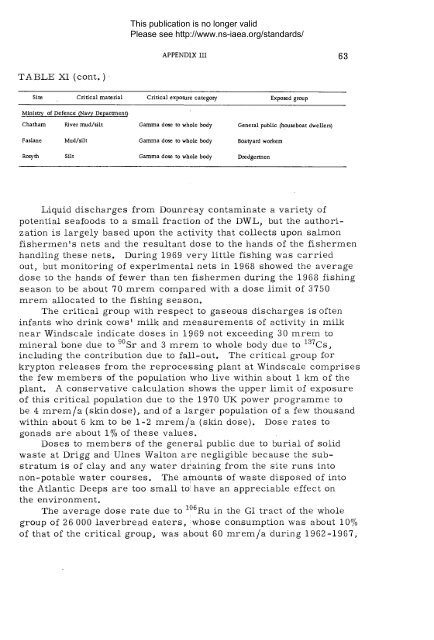Safety_Series_041_1975 - gnssn - International Atomic Energy ...
Safety_Series_041_1975 - gnssn - International Atomic Energy ...
Safety_Series_041_1975 - gnssn - International Atomic Energy ...
Create successful ePaper yourself
Turn your PDF publications into a flip-book with our unique Google optimized e-Paper software.
This publication is no longer valid<br />
Please see http://www.ns-iaea.org/standards/<br />
APPENDIX III 63<br />
T A B L E XI ( c o a t . )<br />
S ite C r it ic a l m a te r ia l C r it ic a l e x p osu re c a te g o r y E xp osed g rou p<br />
M in istry o f D e f e n c e (N a v y D e p a rtm e n t)<br />
C h a th a m R iver m u d /s ilt G a m m a d ose to w h o le b o d y G e n e r a l p u b lic (h o u seb o a t d w e lle rs)<br />
F a sla ne M u d /s ilt G a m m a d ose to w h o le b o d y B oatyard w orkers<br />
R osyth S ilt G a m m a d o se to w h o le b o d y D r e d g e rm e n<br />
Liquid discharges from Dounreay contaminate a variety of<br />
potential seafoods to a small fraction of the DWL, but the authorization<br />
is largely based upon the activity that collects upon salmon<br />
fisherm en's nets and the resultant dose to the hands of the fishermen<br />
handling these nets. During 1969 very little fishing was carried<br />
out, but monitoring of experimental nets in 1968 showed the average<br />
dose to the hands of fewer than ten fishermen during the 1968 fishing<br />
season to be about 70 mrem compared with a dose lim it of 3750<br />
mrem allocated to the fishing season.<br />
The critical group with respect to gaseous discharges is often<br />
infants who drink cow s' milk and measurements of activity in milk<br />
near Windscale indicate doses in 1969 not exceeding 30 mrem to<br />
mineral bone due to 90Sr and 3 m rem to whole body due to 137Cs,<br />
including the contribution due to fall-out. The critical group for<br />
krypton releases from the reprocessing plant at Windscale com prises<br />
the few mem bers of the population who live within about 1 km of the<br />
plant. A conservative calculation shows the upper limit of exposure<br />
of this critical population due to the 1970 UK power programme to<br />
be 4 m rem /a (skindose), and of a larger population of a few thousand<br />
within about 6 km to be 1-2 m rem /a (skin dose). Dose rates to<br />
gonads are about 1% of these values.<br />
Doses to m em bers of the general public due to burial of solid<br />
waste at Drigg and Ulnes Walton are negligible because the substratum<br />
is of clay and any water draining from the site runs into<br />
non-potable water courses. The amounts of waste disposed of into<br />
the Atlantic Deeps are too small to have an appreciable effect on<br />
the environment.<br />
The average dose rate due to 1®6Ru in the GI tract of the whole<br />
group of 26 000 laverbread eaters, whose consumption was about 1 0%<br />
of that of the critical group, was about 60 m rem /a during 1962-1967,

















